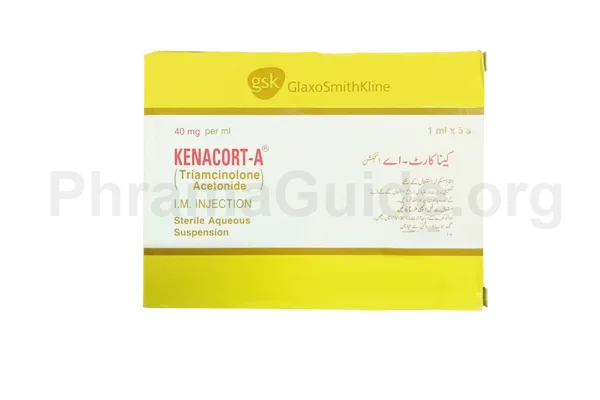Kenacort injection is used in conditions such as allergic reactions, skin disorders, respiratory disorders, arthritis, and certain types of cancer. It is a corticosteroid medication that reduces inflammation and suppresses the immune system’s response. Following are some common and off-label uses of Kenacort injections:
Common Uses of Kenacort Injection
Common uses refer to approved uses of medication by the drug regulatory authorities:
- Inflammatory and Allergic Conditions
- Joint Conditions: Kenacort injection is often used to treat inflammatory joint conditions such as osteoarthritis and rheumatoid arthritis. The injection is administered directly into the affected joint to reduce inflammation and relieve pain.
- Bursitis and Tendonitis: Kenacort Injection may be used for conditions like bursitis and tendonitis to reduce inflammation in the affected area.
- Dermatological Conditions:
- Skin Disorders: Kenacort injection can be used for certain dermatological conditions, including severe cases of psoriasis or other inflammatory skin conditions.
- Allergic Reactions:
- Allergic Reactions: Kenacort injection can be used to manage severe allergic reactions, such as anaphylaxis, when other treatments are not sufficient.
- Respiratory Conditions:
- Asthma: In certain situations, Kenacort injection may be used as a short-term treatment for severe asthma exacerbations.
Off-label Uses of Kenacort Injection
Off-label uses refer to do not approved by the drug regulatory authorities, but are based on clinical experiences by health care professionals:
- Alopecia Areata: Some healthcare providers may use Kenacort injection to treat certain types of alopecia areata, an autoimmune condition that causes hair loss. The injections are often administered into the affected areas of the scalp.
- Hay Fever and Allergies: In some cases, Kenacort injection may be used to manage severe hay fever (allergic rhinitis) or other allergic conditions, particularly when other treatments have not been effective.
- Tenosynovitis: Kenacort injection may be used off-label for the treatment of tenosynovitis, which is inflammation of the tendon sheath. This is often seen in conditions such as trigger fingers.
- Chalazion: Kenacort injection may be used off-label to treat chalazion, which is cysts in the eyelid caused by inflammation of a blocked meibomian gland.
- Synovitis: In cases of persistent joint inflammation (synovitis), Kenacort injection may be considered to reduce inflammation and relieve symptoms.

What is Kenacort?
Kenacort is one of the leading injectable brands of Triamcinolone Acetonide, manufactured and marketed by GlaxoSmithKline (GSK).
Kenacort Injection’s Alternatives : Other Similar Brands
The following brands are some available Injections of Triamcinolone Acetonide and their manufacturers.
- K-Kort : Ophth Pharma (Pvt) Ltd, Pakistan.
- Lonacort : Zafa Pharmaceutical Laboratories (Pvt) Ltd, Pakistan.
- Triton : Mass Pharma (Pvt) Ltd, Pakistan.
- Amrokort : Amros Pharmaceuticals, Pakistan.
- Dexafort : Cirin Pharmaceuticals (Pvt) Ltd, Pakistan.
- Lawrcort : Lawrence Pharma, Pakistan.
- Medicort : Medicraft Pharmaceuticals (Pvt) Ltd, Pakistan.
- M-cort : Mediate Pharmaceuticals (Pvt) Ltd, Pakistan.
- Vibra : Fassgen Pharmaceuticals, Pakistan.
- Danacort : Danas Pharmaceuticals (Pvt) Ltd, Pakistan.
Kenacort : Available Formulations and Strengths
Presently, Kenacort is available in Injection form.
Kenacort Injection : 40mg/ml strength.
Who Should Not Use Kenacort Injection?
- Hypersensitivity or Allergic Reactions: Individuals who have a known hypersensitivity or allergy to Triamcinolone acetonide or any component of the injection should not use Kenacort.
- Systemic Fungal Infections: Kenacort infection is a corticosteroid that can suppress the immune system. It is contraindicated in individuals with systemic fungal infections unless they are already receiving appropriate antifungal therapy.
- Administration of Live or Live Attenuated Vaccines: The use of Kenacort injection injections is generally contraindicated in individuals who are currently receiving live or live attenuated vaccines due to the immunosuppressive effects of corticosteroids.
- Peptic Ulcer Disease: Kenacort injection injections can exacerbate peptic ulcer disease. They should be used with caution or avoided in individuals with active or latent peptic ulcers.
- Diverticulitis: The use of corticosteroids, including Kenacort injection, is generally contraindicated in individuals with diverticulitis due to the potential for perforation.
- Uncontrolled Hypertension: Corticosteroids can elevate blood pressure, and the use of Kenacort injection injections should be approached with caution or avoided in individuals with uncontrolled hypertension.
- Psychiatric Disorders: Individuals with a history of psychiatric disorders or those with a predisposition to mood disturbances should use Kenacort injection with caution, as corticosteroids can affect mood and behavior.
Recommended Dosage and Administration of Kenacort Injection?
Kenacort Intra-Articular Use (Joint Injections):
- The recommended dosage for intra-articular use (injection into a joint space) depends on the size of the joint.
- For smaller joints, such as the knee, an average dose might range from 2.5 to 5 mg.
- Larger joints may require higher doses.
Kenacort Soft Tissue Injections:
- For soft tissue injections, the recommended dosage can vary based on the specific condition being treated.
- Typically, lower doses may be used for soft tissue injections compared to joint injections.
Kenacort Intramuscular Use:
- Intramuscular injections involve administering the medication into the muscle.
- The dosage for intramuscular use can vary, but it is often in the range of 20 to 40 mg, depending on the condition and severity.
Kenacort Injection for Keloid and Hypertrophic Scars:
- For the treatment of keloid and hypertrophic scars, smaller doses ranging from 2.5 to 10 mg may be used.
- The injection is often administered directly into the scar tissue.
How Kenacort Works?
Kenacort Injection is a corticosteroid medication that exerts its anti-inflammatory effects through a multifaceted mechanism of action. It works by suppressing the production and release of inflammatory mediators, such as leukotrienes, prostaglandins, and histamine, which contribute to the signs and symptoms of inflammation.

Leave A Comment